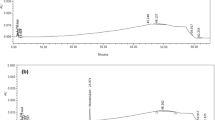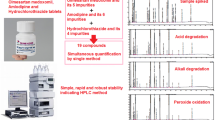Abstract
The aim of this study is to develop and validate a sensitive and specific stability-indicating reversed-phase high-performance liquid chromatographic (RP-HPLC) method for the quantitative determination of Sugammadex sodium together with its process and possible degradation impurities. The pKa value is 2.82. The chromatographic conditions have been optimized by the Hypersil Gold 250 mm X 4.6 mm, 3 µ RP-18 columns with gradient elution using a mobile phase composed of 0.1% phosphoric acid, acetonitrile, and methanol. The eluents were monitored at 205 nm with a flow rate of 1.0 mL/min with an injection volume of 20 µL. The optimized method produced symmetrical and sharp peaks with good separation between the process and degradation impurities. The forced degradation study was carried out under acid, base, oxidation, and thermal conditions to demonstrate the stability-indicating capability of the method. The method was validated as per the International Council for Harmonisation of Technical Requirements for Pharmaceuticals for Human Use (ICH) Q2 (R1) and showed excellent specificity, precision, linearity, accuracy, and robustness. The developed HPLC method was precise with a value of 0.25%. The relative standard deviation of accuracy represented by the recovery studies ranged between 89.5% and 104.6%. Linearity analyses indicated a correlation coefficient value of greater than 0.996 for Sugammadex and its known impurities. The LOD and LOQ values for Sugammadex ranged from 0.017% to 0.050%, and for its related impurities, they ranged from 0.015% to 0.055%. The stability of the analytical solution was evaluated and was stable for 75 h when stored at 5 °C. No chromatographic interference was observed during the degradation studies and also in the blank chromatogram.




Similar content being viewed by others
References
Kovac AL (2009) Sugammadex: the first selective binding reversal agent for neuromuscular block. J Clin Anesth 21(6):444–453
Rahe-Meyer N, Berger C, Wittmann M, Solomon C, Abels E, Rietbergen H, Reuter D (2015) Recovery from prolonged deep rocuronium-induced neuromuscular blockade. Anaesthesist 64(7):506–512
Lemmens HJM, El-Orbany MI, Berry J, Morte JB, Martin G (2010) Reversal of profound vecuronium-induced neuromuscular block under sevoflurane anesthesia: sugammadex versus neostigmine. BMC Anesthesiol 10(1):1–10
Khuenl-Brady KS, Wattwil M, Vanacker BF, Lora-Tamayo JI, Rietbergen H, Álvarez-Gómez JA (2010) Sugammadex provides faster reversal of vecuronium-induced neuromuscular blockade compared with neostigmine: a multicenter, randomized, controlled trial. Anesth Analg 110(1):64–73
Jones RK, Caldwell JE, Brull SJ, Soto RG (2008) Reversal of profound rocuronium-induced blockade with sugammadex: a randomized comparison with neostigmine. J Am Soc Anesthesiol 109(5):816–824
Geldner G, Niskanen M, Laurila P, Mizikov V, Hübler M, Beck G, Rietbergen H, Nicolayenko E (2012) A randomized controlled trial comparing sugammadex and neostigmine at different depths of neuromuscular blockade in patients undergoing laparoscopic surgery. Anaesthesia 67(9):991–998
De Zwart MA, ten Bruggencate-Broeders J, Van Hal HJ, Megens RHJ, Frasa HWL (2011) Determination of sugammadex in human plasma, urine, and dialysate using a high-performance liquid chromatography/tandem mass spectrometry assay. J Chromatogr B 879(19):1573–1586
Chakravarthy A, Sailaja BBV, Praveen Kumar A (2017) Method development and validation of ultraviolet-visible spectroscopic method for the estimation of assay of sugammadex sodium, apremilast, riociguat, and vorapaxar sulfate drugs in active pharmaceutical ingredient form. Asian J Pharm Clin Res 10(2):241–250
Aluc K, Kaya G, Gokalp M (2021) A validated ultra –high-pressure liquid chromatography method for separation of sugammadex related substances and its detergents in drug products. Global J Pharm Pharmaceut Sci 8(3):2573–2250
Mashru R, Parekh H, Chokshi P (2020) Analytical Method Development and Validation for the Estimation of Sugammadex. J Drug Deliv Therapeut 10(1):52–59
Gijsenbergh F, Ramael S, Houwing N, van Iersel T (2005) First human exposure of Org 25969, a novel agent to reverse the action of rocuronium bromide. J Am Soc Anesthesiol 103(4):695–703
Nicholson WT, Sprung J, Jankowski CJ (2007) Sugammadex: a novel agent for the reversal of neuromuscular blockade. Pharmacother J Hum Pharmacol Drug Ther 27(8):1181–1188
Bom A, Epemolu O, Hope F, Rutherford S, Thomson K (2007) Selective relaxant binding agents for reversal of neuromuscular blockade. Curr Opin Pharmacol 7(3):298–302
Lemmens HJ, El-Orbany MI, Berry J, Morte JB, Martin G (2010) Reversal of profound vecuronium-induced neuromuscular block under sevoflurane anesthesia: sugammadex versus neostigmine. BMC Anesthesiol 10(1):1–10
Welliver M (2006) New drug sugammadex: a selective relaxant binding agent. AANA J 74(5):357–363
I.H.T. Guideline, Impurities in new drug substances Q3A (R2) (2006) In Proceedings of the International Conference on Harmonization of Technical Requirements for Registration of Pharmaceuticals for Human Use, Geneva, Switzerland, 25
I.H.T. Guideline (2005). Validation of analytical procedures: text and methodology, Q2 (R1), 1 ,1–15
Merrill JC. (1987). HPLC for Pharmaceutical scientist.Am. Lab. 7481.
Bliesner DM (2006) Validating Chromatographic Methods. John Wiley. 88–92
A Guide to Validation in HPLC Based on the Work of G.M. Hearn Perkin Elmer. R.A. van Iterson Drenthe College Emmen Holland for www.standard base.com. Accessed April 05, 2013
International Conference on Harmonisation of Technical Requirements for Registration of Pharmaceuticals for Human Use (2005). “ICH Q2 (R1) Validation of Analytical Procedures: Text and Methodology,” vol. 1994, 17.
FDA (2014) Guidance for Industry Analytical Procedures and Methods Validation for Drugs and Biologics
Kavitapu DR, Maruthapillai A, Mahapatra S, Selvi JA (2021) New stability-indicating RP-HPLC method for the determination of Abiraterone acetate, its related substances and degradation products in bulk and dosage form. Mater Today Proc 34:469–478
ICH Harmonised Tripartite Guideline Q1A (R2) (2003) Stability Testing of New Drug Substances and Products
Sabir AM, Moloy M, Bhasin PS (2013) HPLC method development and validation: A review. Int Res J Pharm 4(4):39–46
Ragham PK, Chandrasekhar KB (2016) Development and validation of a stability-indicating RP-HPL C-CAD method for gabapentin and its related impurities in presence of degradation products. J Pharm Biomed Anal 125:122–129
Sahu PK, Ramisetti NR, Cecchi T, Swain S, Patro CS, Panda J (2018) An overview of experimental designs in HPLC method development and validation. J Pharm Biomed Anal 147:590–611
Ngwa G (2010) Forced degradation as an integral part of HPLC stability-indicating method development. Drug Delivery Tech 10(5):56–59
I.S. Committee (1996) ICH Q2B validation of analytical procedures: methodology. European agency for the evaluation of medicinal products, International commission on harmonisation, London, (CPMP/ICH/281/95)
I.S. Committee (1996) ICH Q2B validation of analytical procedures: methodology. European agency for the evaluation of medicinal products, International commission on harmonisation, London (CPMP/ICH/281/95)
U. S. Pharmacopeia (2009). “USP-NF <1225> Validation of Compendial Methods,” USP 32-NF27
Funding
The author, Dr. K. Venkatachalam is extremely thankful for the financial help for the DST-SERB project of the Department of Science and Technology, India (Ref. No EEQ/2016/000559, Date: 06.02.2017).
Author information
Authors and Affiliations
Corresponding author
Ethics declarations
Conflicts of interest
There are no conflicts of interest.
Additional information
Publisher's Note
Springer Nature remains neutral with regard to jurisdictional claims in published maps and institutional affiliations.
Rights and permissions
About this article
Cite this article
Barnabas, K.S., Suvaitha, S.P. & Venkatachalam, K. Development and Validation of Stability Indicating RP-HPLC Method for the Determination of Process and Degradation-Related Impurities in Sugammadex Sodium Drug Substance. Chromatographia 85, 405–419 (2022). https://doi.org/10.1007/s10337-022-04146-y
Received:
Revised:
Accepted:
Published:
Issue Date:
DOI: https://doi.org/10.1007/s10337-022-04146-y




